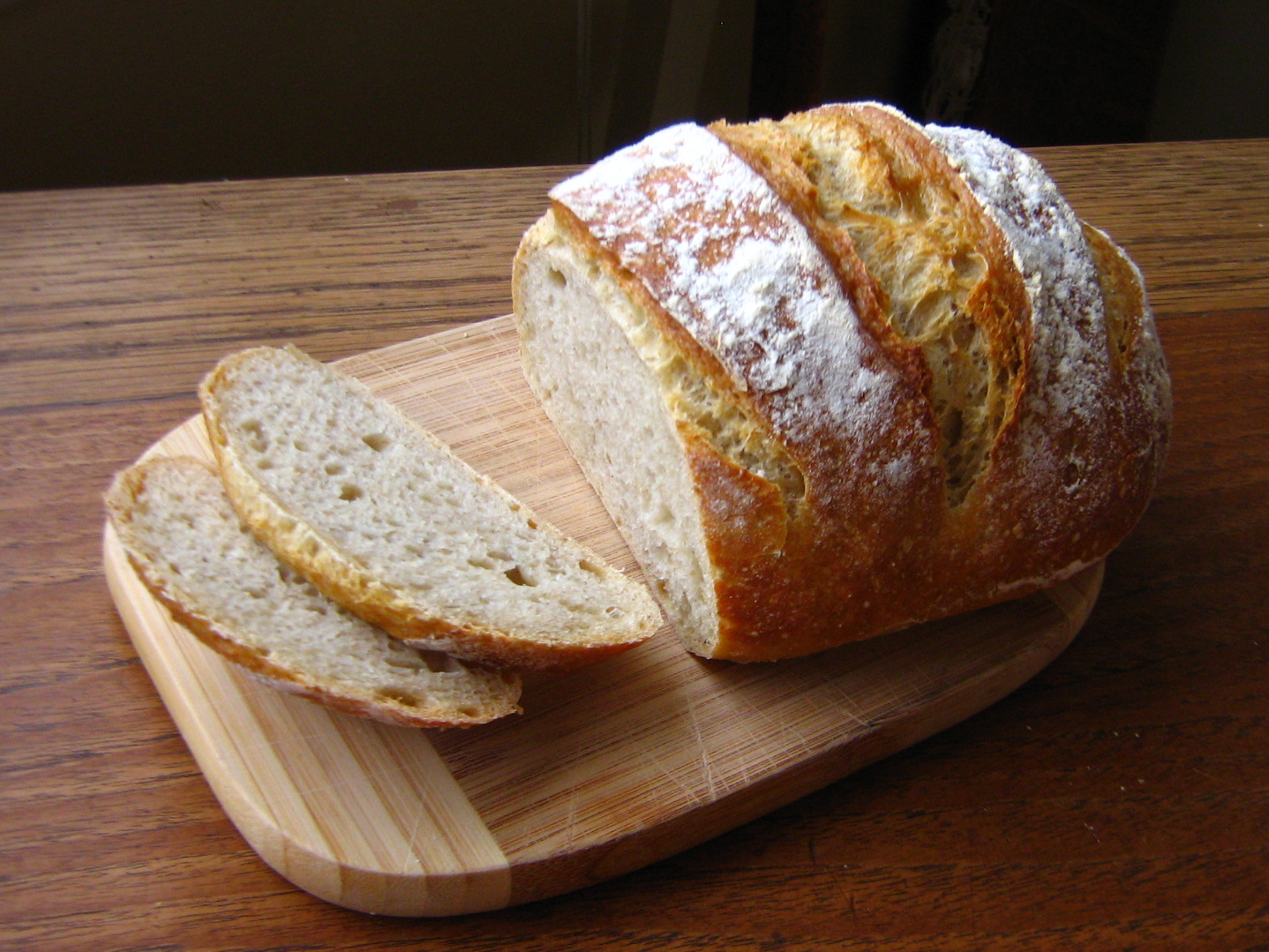 I bought the book Artisan Bread in 5 Minutes a Day a few years ago after seeing a post on Steamy Kitchen about the caramel pecan cinnamon rolls that come from the book. I made the rolls and immediately knew I had to have the book, they were so good. The premise of the recipes in the book is to stir up a batch of very wet (high hydration) dough which you store in the fridge and then pull off a chunk to bake as desired. The wet dough plus the long rising and fermentation time develops the gluten in the dough without the need for kneading (heh!) and results in a delicious bread with a chewy crust and airy interior (which I’m still working to perfect) that literally only takes about five minutes of active time – the rest is just… rest. I have been making this bread exclusively for about two and a half months now, and we have not bought any bread in that time – just a lot of flour!
I bought the book Artisan Bread in 5 Minutes a Day a few years ago after seeing a post on Steamy Kitchen about the caramel pecan cinnamon rolls that come from the book. I made the rolls and immediately knew I had to have the book, they were so good. The premise of the recipes in the book is to stir up a batch of very wet (high hydration) dough which you store in the fridge and then pull off a chunk to bake as desired. The wet dough plus the long rising and fermentation time develops the gluten in the dough without the need for kneading (heh!) and results in a delicious bread with a chewy crust and airy interior (which I’m still working to perfect) that literally only takes about five minutes of active time – the rest is just… rest. I have been making this bread exclusively for about two and a half months now, and we have not bought any bread in that time – just a lot of flour!
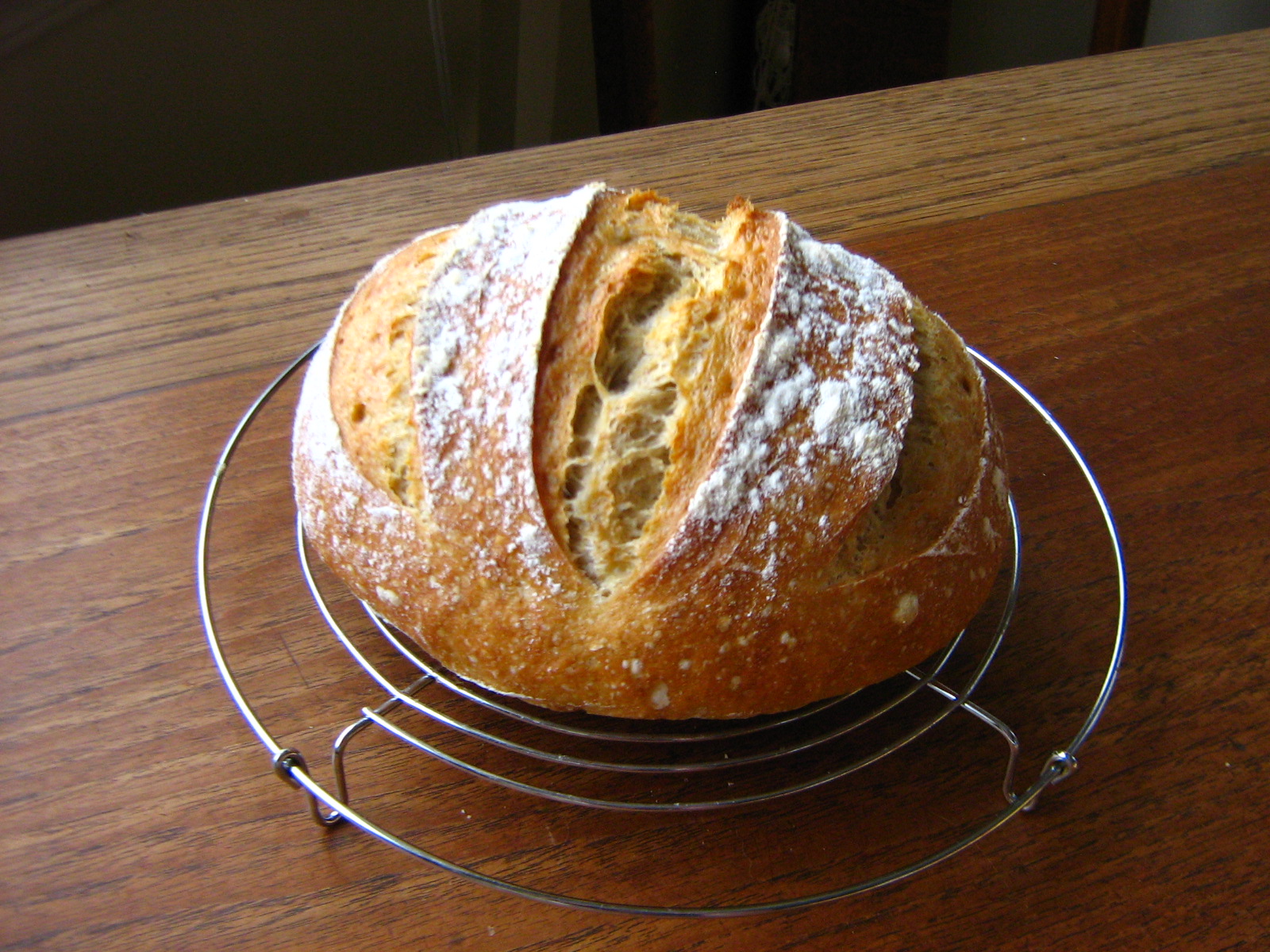 Artisan Bread in 5 Minutes a Day gives recipes for dozens of different bread doughs, ranging from peasant breads to multigrain breads to flatbreads and pizzas to breads enriched with butter, honey and eggs (such as challah and brioche, great for making caramel pecan rolls!), all of which can be varied with different flavours and additions (herbs, spices, dried fruit, cheese, olives, etc) to create pretty much whatever you can dream up. This recipe is for the basic Master Dough, which is a lean dough (just flour, water, yeast and salt) that can be baked into boules (as shown), baguettes, couronnes (like a giant bagel), or even used as pizza crust. It makes great sandwiches when it is fresh, and wonderful toast when it is a day or so old. One batch of dough makes enough for four small one pound loaves, which each last me and Nate about two days.
Artisan Bread in 5 Minutes a Day gives recipes for dozens of different bread doughs, ranging from peasant breads to multigrain breads to flatbreads and pizzas to breads enriched with butter, honey and eggs (such as challah and brioche, great for making caramel pecan rolls!), all of which can be varied with different flavours and additions (herbs, spices, dried fruit, cheese, olives, etc) to create pretty much whatever you can dream up. This recipe is for the basic Master Dough, which is a lean dough (just flour, water, yeast and salt) that can be baked into boules (as shown), baguettes, couronnes (like a giant bagel), or even used as pizza crust. It makes great sandwiches when it is fresh, and wonderful toast when it is a day or so old. One batch of dough makes enough for four small one pound loaves, which each last me and Nate about two days.
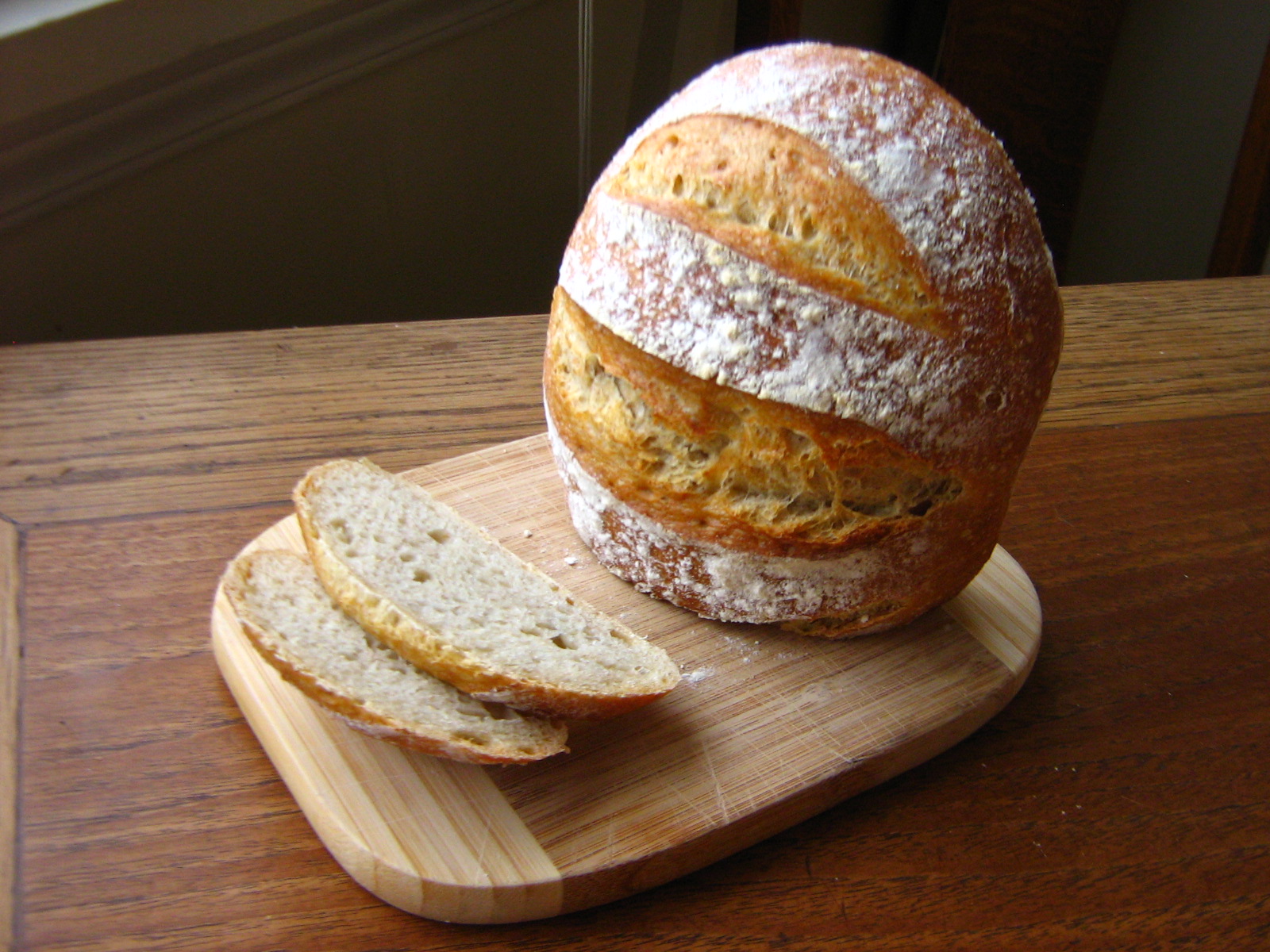 Bread often gets put in the black books of healthy eating, but not all bread is created equal. Floppy white grocery store bread that travels to the store in a bag and lasts two weeks without getting stale or mouldy is totally inferior to crusty, fresh-baked, open-crumbed artisan bread – not just aesthetically but also as a food source. I recently learned that the longer it takes for bread to rise and ferment, the better it is for you. This is because the yeasts and bacteria in the bread actually break down and partially digest the carbs and sugars, and the longer they have to do this, the easier the bread is to digest. This is especially true if the bread contains whole grains, which become more nutritionally available to your body with a long fermentation time (otherwise they’re just fiber). Artisan bread, with its long production time (usually several hours, and sometimes days!), is therefore easier to digest and more nutritious than bagged grocery store bread, which is made so expediently that the yeast doesn’t have time to break anything down, and is also pumped so full of additives and preservatives that it can’t break down, period.
Bread often gets put in the black books of healthy eating, but not all bread is created equal. Floppy white grocery store bread that travels to the store in a bag and lasts two weeks without getting stale or mouldy is totally inferior to crusty, fresh-baked, open-crumbed artisan bread – not just aesthetically but also as a food source. I recently learned that the longer it takes for bread to rise and ferment, the better it is for you. This is because the yeasts and bacteria in the bread actually break down and partially digest the carbs and sugars, and the longer they have to do this, the easier the bread is to digest. This is especially true if the bread contains whole grains, which become more nutritionally available to your body with a long fermentation time (otherwise they’re just fiber). Artisan bread, with its long production time (usually several hours, and sometimes days!), is therefore easier to digest and more nutritious than bagged grocery store bread, which is made so expediently that the yeast doesn’t have time to break anything down, and is also pumped so full of additives and preservatives that it can’t break down, period.
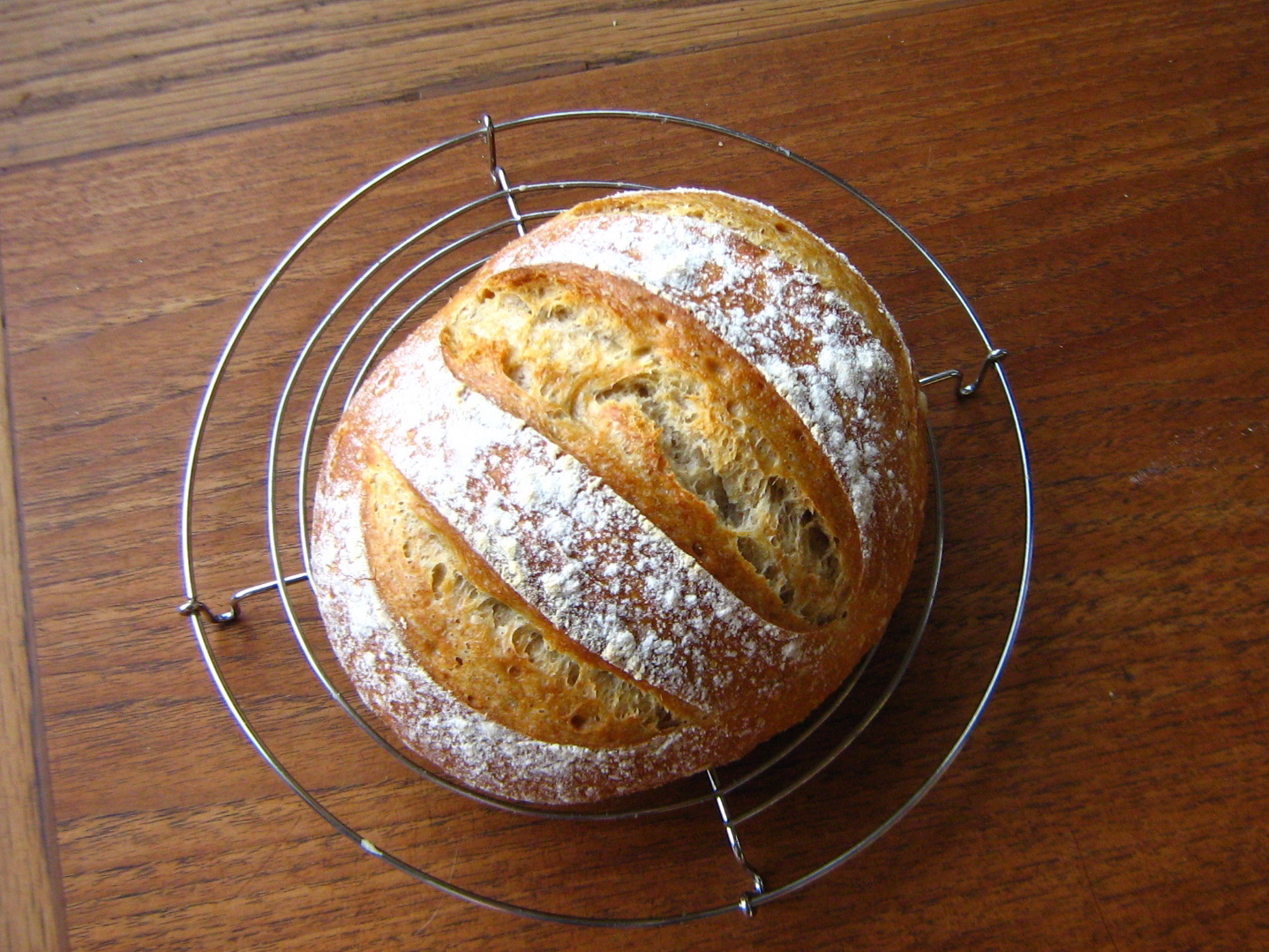 Another thing I learned is that the crust plays an important role. A chewy, crunchy bread crust forces you to actually chew your food (mechanical digestion), and also stimulates saliva, which starts breaking down the nutrients (chemical digestion), making the job of your stomach much easier – again, being hard to digest is one reason many people avoid bread. Soft, floppy, crustless bread that you don’t even have to chew is definitely going to sit in your stomach and make you feel ill, so don’t even bother with it: go straight for the crusty, delicious artisan bread and do your stomach and your taste buds a favour!
Another thing I learned is that the crust plays an important role. A chewy, crunchy bread crust forces you to actually chew your food (mechanical digestion), and also stimulates saliva, which starts breaking down the nutrients (chemical digestion), making the job of your stomach much easier – again, being hard to digest is one reason many people avoid bread. Soft, floppy, crustless bread that you don’t even have to chew is definitely going to sit in your stomach and make you feel ill, so don’t even bother with it: go straight for the crusty, delicious artisan bread and do your stomach and your taste buds a favour!
(I apologize for spending the last two paragraphs talking about digestion – I know it’s not the most appetizing thing to read about on a food blog, but I thought it was cool, so… yeah ;). )
Anyway, here is the recipe. Definitely try it, and also check out the Artisan Bread in 5 Minutes a Day website, where the book’s authors post all kinds of awesome tips, tricks, videos, and additional recipes for their breads :).
No-Knead Crusty Artisan Bread
This is my adapted version of the Master Recipe from Artisan Bread in 5 Minutes a Day. I use a reduced amount of salt, a mixture of all purpose and whole wheat flours, and have increased the amount of water to get the moisture level right (see notes below). I also bake the dough on parchment paper, rather than using a pizza peel to transfer the loaf to and from the pizza stone in the oven. You will need a large bowl or container (4-6 quarts in size) with a lid in which to mix and store the dough, and preferably a pizza stone (aka a baking stone) on which to bake the bread (but there are other ways to bake it too – see notes below). The dough can be stored for up to 2 weeks in the fridge – the longer it is stored, the more of a sourdough flavour it gets. Makes about 4 lbs of dough – enough for 4 x 1 lb loaves.
In a large (4-6 quart) bowl or container with a lid, mix together:
3 1/3 cups warm water (this is the amount that works for me with higher protein Canadian all-purpose flour – your experience may vary)
1 tbsp coarse sea salt
1 1/2 tbsp granulated yeast – instant, regular, whatever
 Don’t worry if it doesn’t all dissolve nicely.
Don’t worry if it doesn’t all dissolve nicely.
In a slightly smaller bowl, combine:
5 1/2 cups unbleached all-purpose flour (unbleached is important!)
1 cup whole wheat flour
(or 6 1/2 cups unbleached all-purpose flour only)
Measure the flour by “scooping and sweeping”, like so:
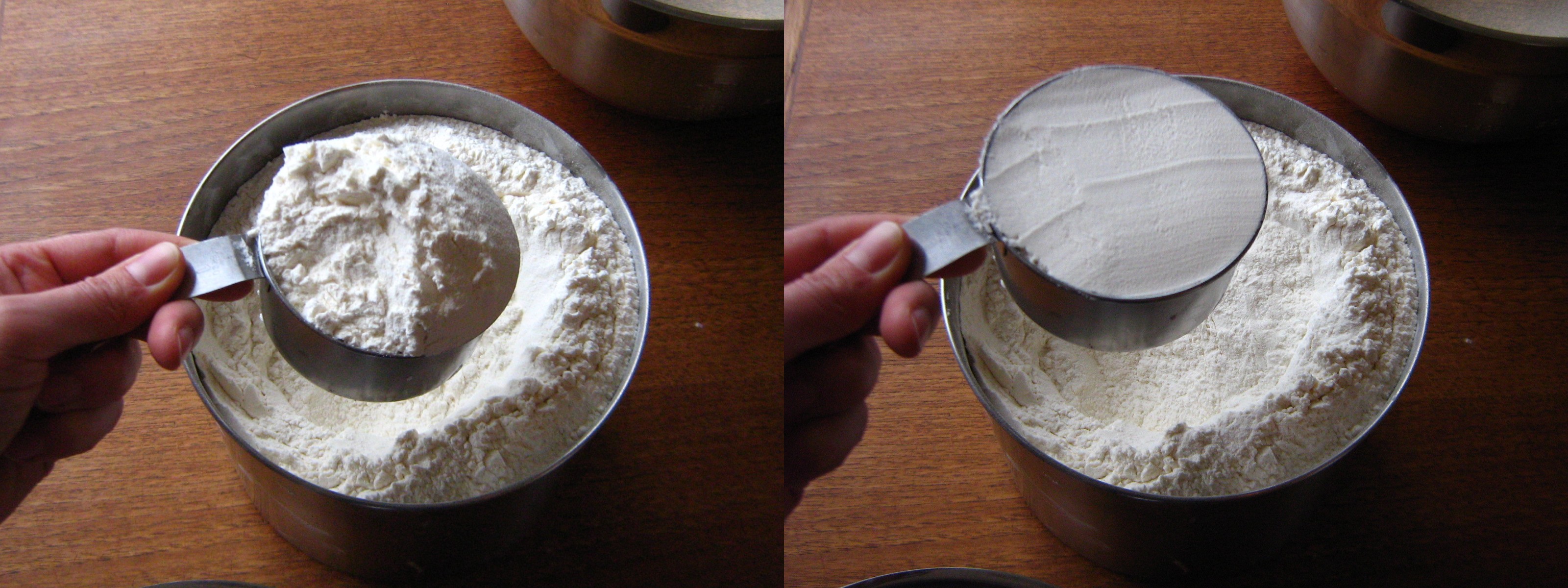 Dump the flour into the water mixture and stir it briskly until it is evenly moistened. You can get in there with your hands if you need to – just resist the urge to knead!
Dump the flour into the water mixture and stir it briskly until it is evenly moistened. You can get in there with your hands if you need to – just resist the urge to knead!  The resulting dough should be very wet and sticky.
The resulting dough should be very wet and sticky. 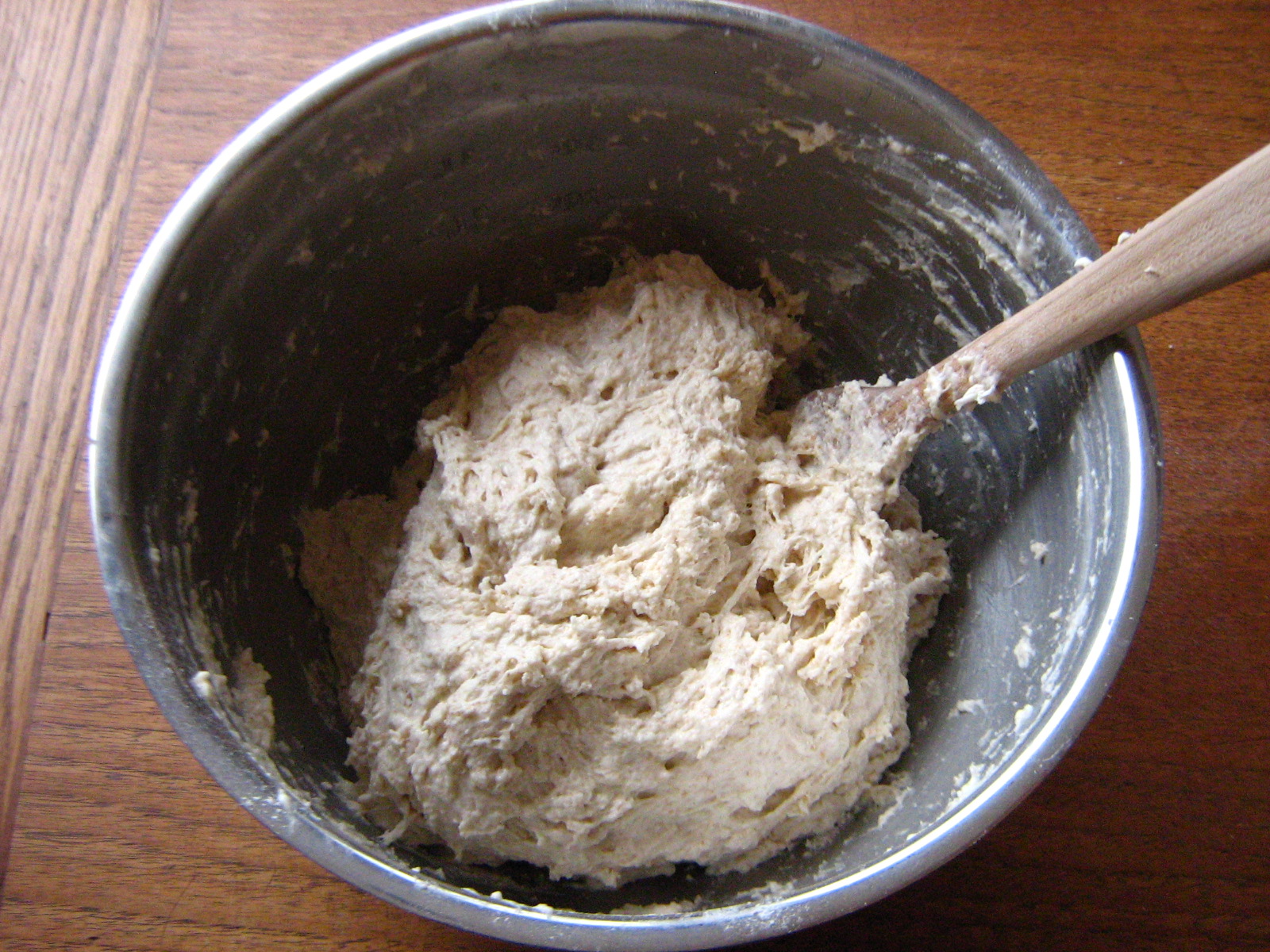 Put the lid on the bowl/container – you don’t want an air-tight seal, but you do want the dough covered completely so it doesn’t dry out (I usually put a jar of peanut butter on top of the bowl to keep the lid down!).
Put the lid on the bowl/container – you don’t want an air-tight seal, but you do want the dough covered completely so it doesn’t dry out (I usually put a jar of peanut butter on top of the bowl to keep the lid down!). 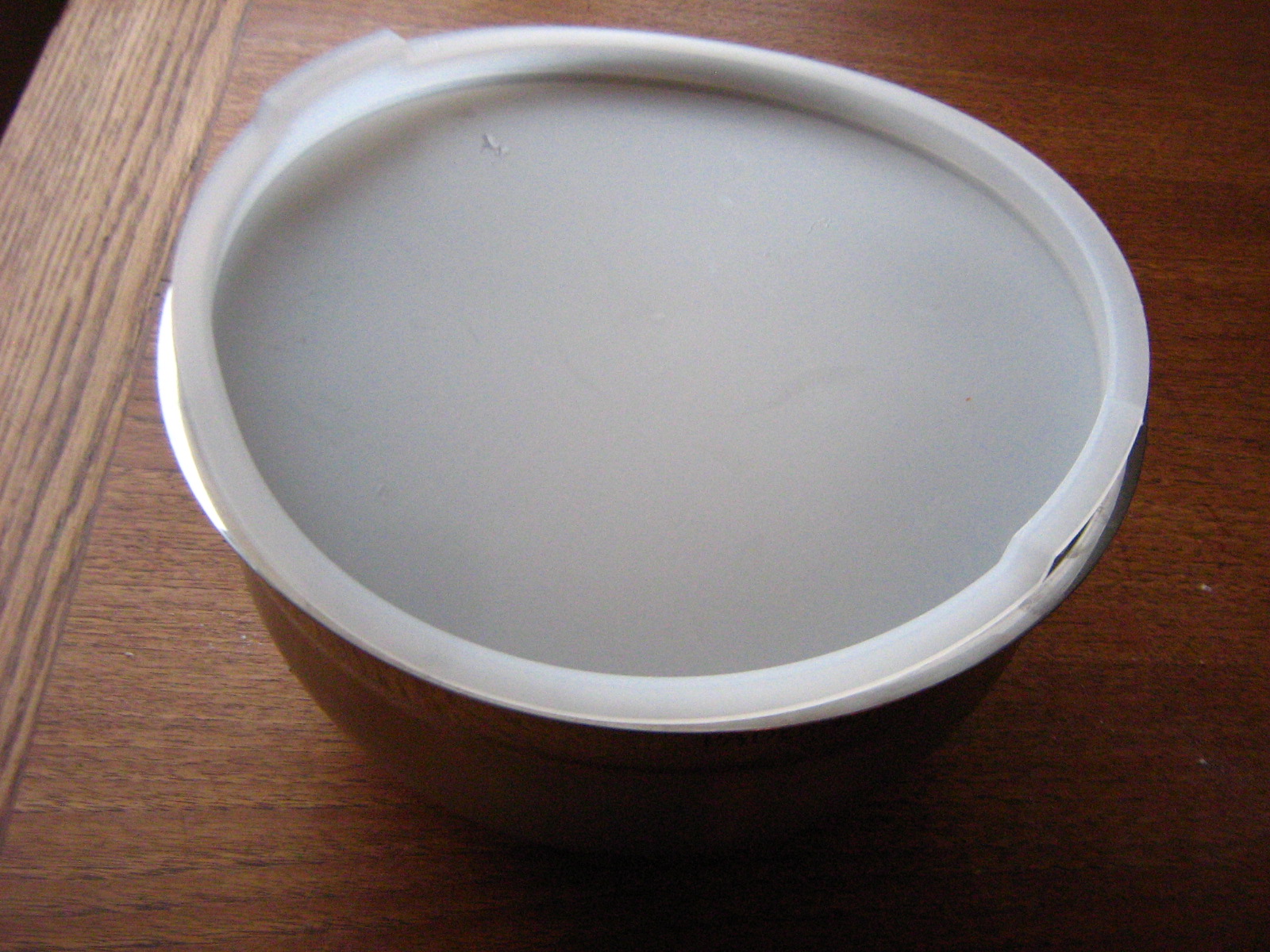 Leave the dough to rise at room temperature for 2 hours or until the top starts to flatten out and deflate a little bit, after which it will look something like this:
Leave the dough to rise at room temperature for 2 hours or until the top starts to flatten out and deflate a little bit, after which it will look something like this:  All those bubbles are going to make your bread lovely and airy, so don’t squish it down, whatever you do. Place the covered container in the fridge and refrigerate for at least a few hours – the dough can be baked with after the first 2 hour rise but is much easier to handle after being chilled. Store in the fridge up to 2 weeks.
All those bubbles are going to make your bread lovely and airy, so don’t squish it down, whatever you do. Place the covered container in the fridge and refrigerate for at least a few hours – the dough can be baked with after the first 2 hour rise but is much easier to handle after being chilled. Store in the fridge up to 2 weeks.
When you are ready to bake bread, take the dough out of the fridge and sprinkle a small part of the surface with flour so it doesn’t stick to your hands (you will notice that the dough has sunk quite a bit – this is fine because as long as you don’t press it down, all the bubbles are still intact!). Grab the floured dough and pull out about 1 lb of dough (the size of a grapefruit). I use scissors to cut off the chunk of dough. 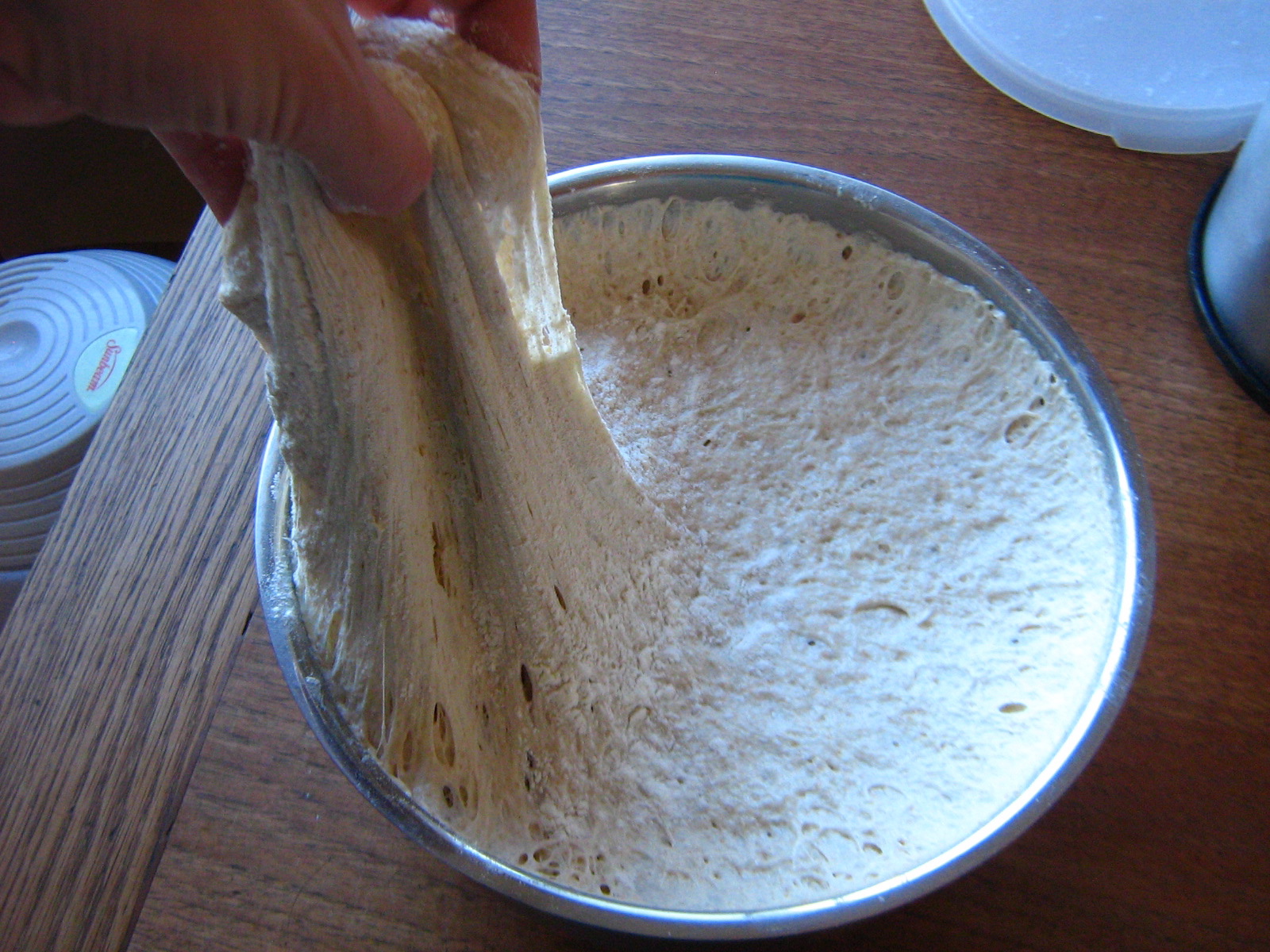
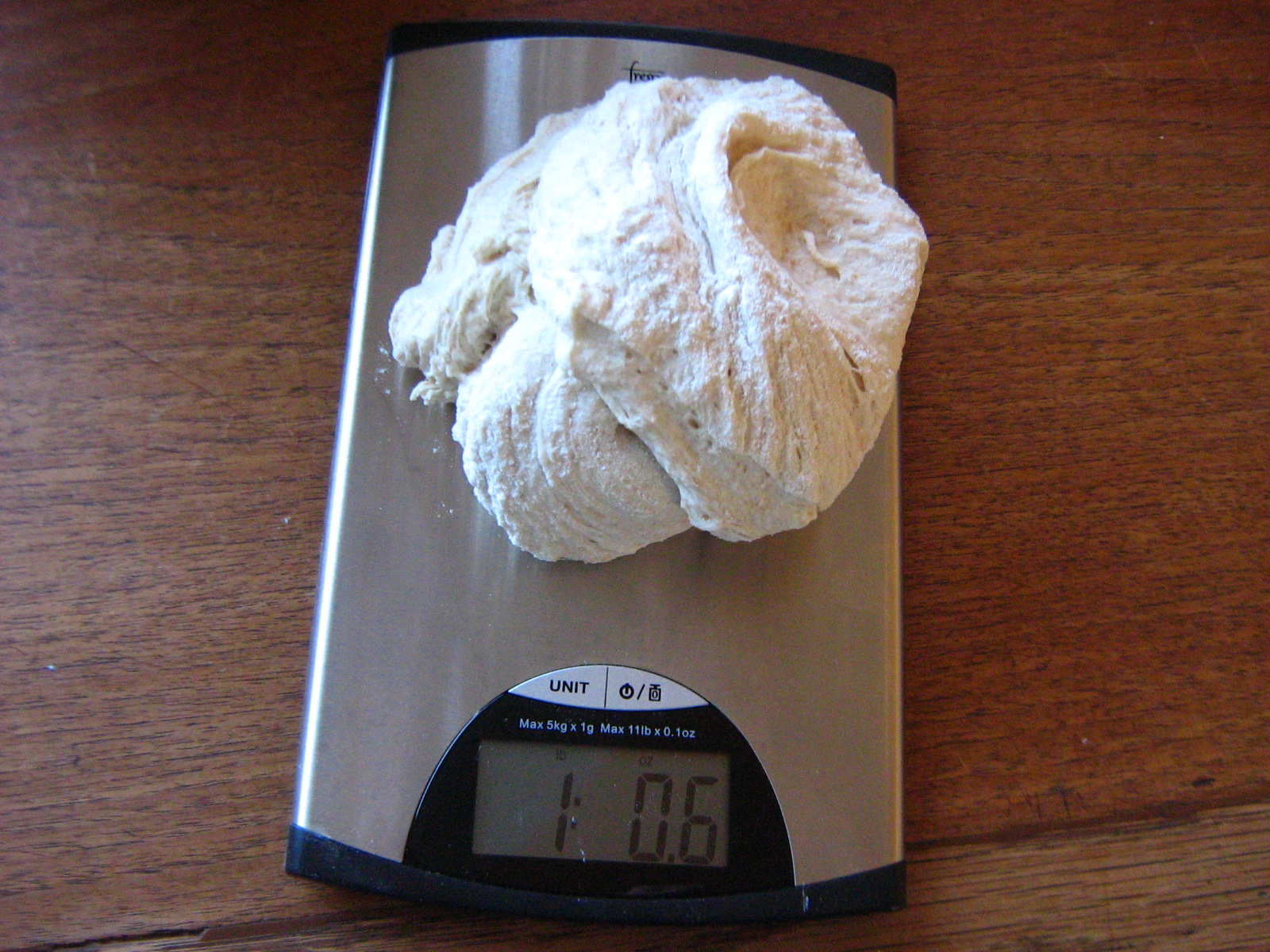 Try not to squash the dough too much, and don’t knead it! Pick it up in your hands, dust it with a little bit more flour and quickly shape it into a ball (or “boule”) by gently pulling the top of the dough and tucking it underneath. Try to do this by handling it as little as possible (this takes some practice) – it should take about 5 seconds tops.
Try not to squash the dough too much, and don’t knead it! Pick it up in your hands, dust it with a little bit more flour and quickly shape it into a ball (or “boule”) by gently pulling the top of the dough and tucking it underneath. Try to do this by handling it as little as possible (this takes some practice) – it should take about 5 seconds tops. 
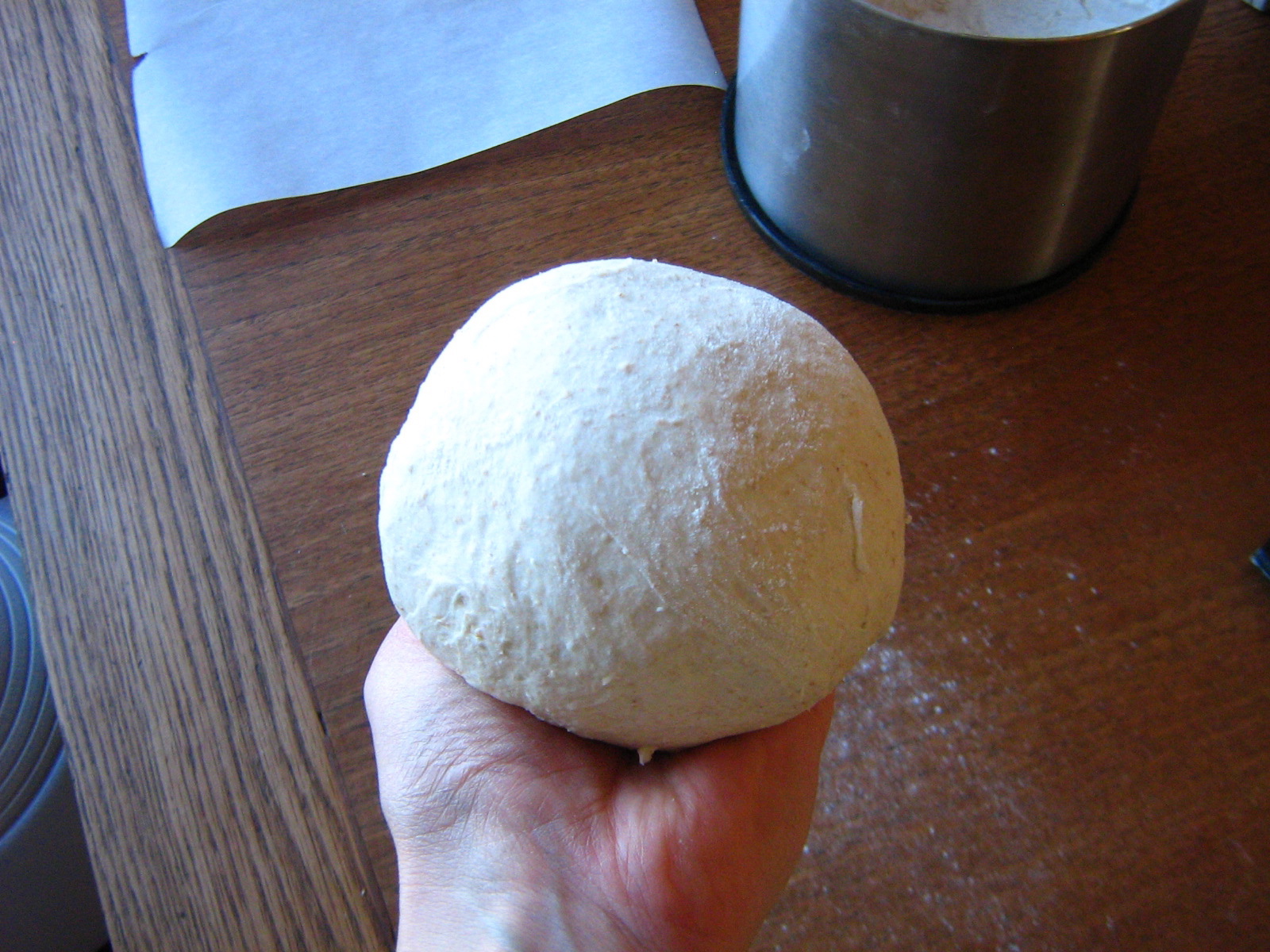 Place the ball of dough, tucked ends down, into a piece of parchment paper. Let it rest, uncovered, at room temperature for 40-90 minutes.
Place the ball of dough, tucked ends down, into a piece of parchment paper. Let it rest, uncovered, at room temperature for 40-90 minutes.  With about 20 minutes left in the rest period, prepare the oven. Place a pizza stone on a central shelf, and on any other shelf that won’t interfere with the rising bread (below is good!), place a metal roasting pan. Heat the oven to 450˚F and let it preheat for at least 20 minutes (your pizza stone may take longer to heat up completely).
With about 20 minutes left in the rest period, prepare the oven. Place a pizza stone on a central shelf, and on any other shelf that won’t interfere with the rising bread (below is good!), place a metal roasting pan. Heat the oven to 450˚F and let it preheat for at least 20 minutes (your pizza stone may take longer to heat up completely). When the oven is preheated and the dough is fully rested, dust the shaped boule with flour and slash it about 1/4″ deep with a serrated knife – this allows the bread to expand in the oven in a predictable fashion, rather than splitting open randomly. Depending on the age of the stored dough, at the end of the rest period it may not have changed much in size or shape (fresher dough) or it may have flattened out (older dough), but it should jiggle if you tug on the parchment paper.
When the oven is preheated and the dough is fully rested, dust the shaped boule with flour and slash it about 1/4″ deep with a serrated knife – this allows the bread to expand in the oven in a predictable fashion, rather than splitting open randomly. Depending on the age of the stored dough, at the end of the rest period it may not have changed much in size or shape (fresher dough) or it may have flattened out (older dough), but it should jiggle if you tug on the parchment paper. 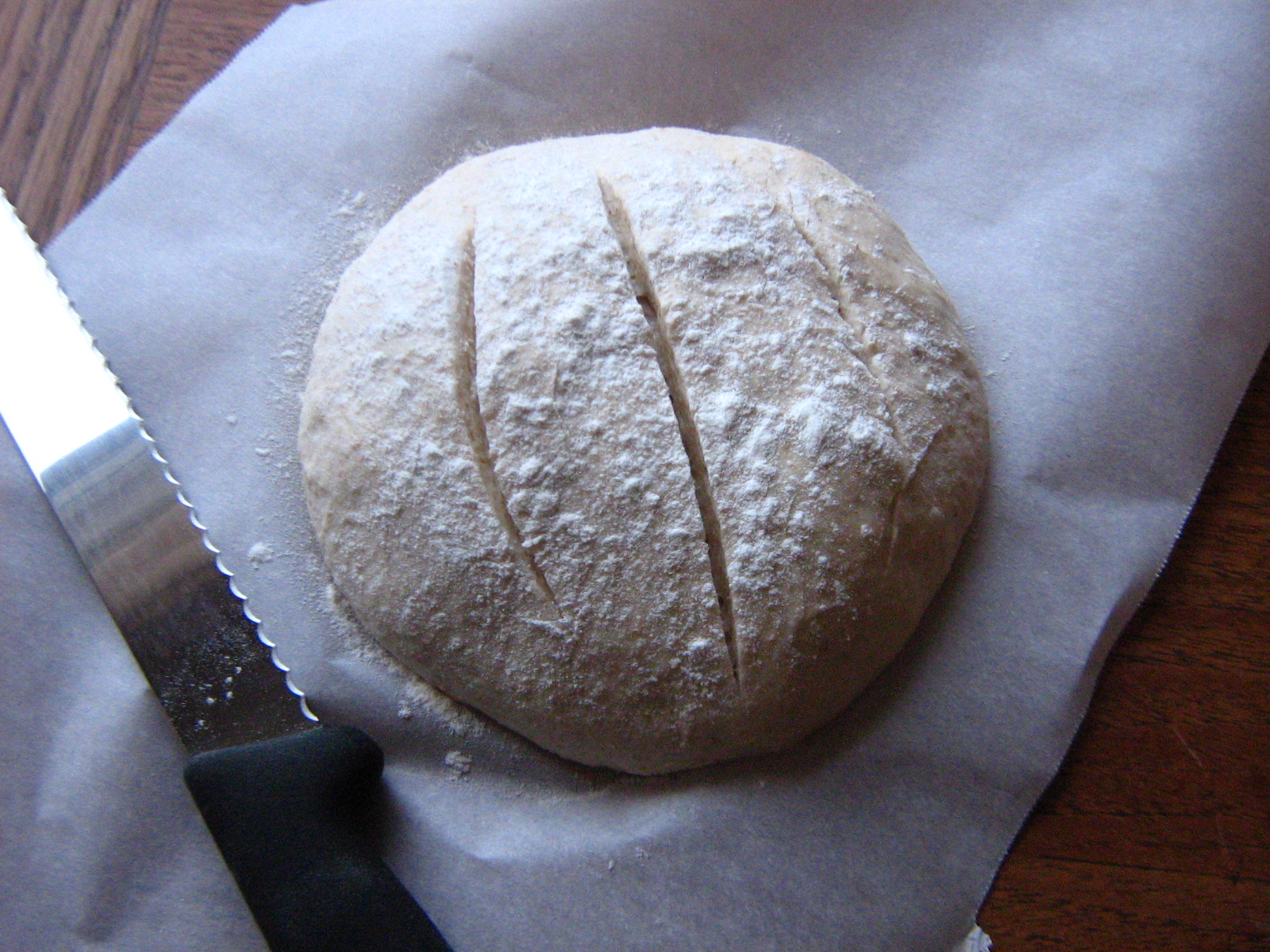 Place the dough and parchment paper on the preheated pizza stone, then pour a mug full of hot tap water into the roasting pan, and shut the door quickly to trap the steam. The steam helps make the crust crisp and brown.
Place the dough and parchment paper on the preheated pizza stone, then pour a mug full of hot tap water into the roasting pan, and shut the door quickly to trap the steam. The steam helps make the crust crisp and brown. 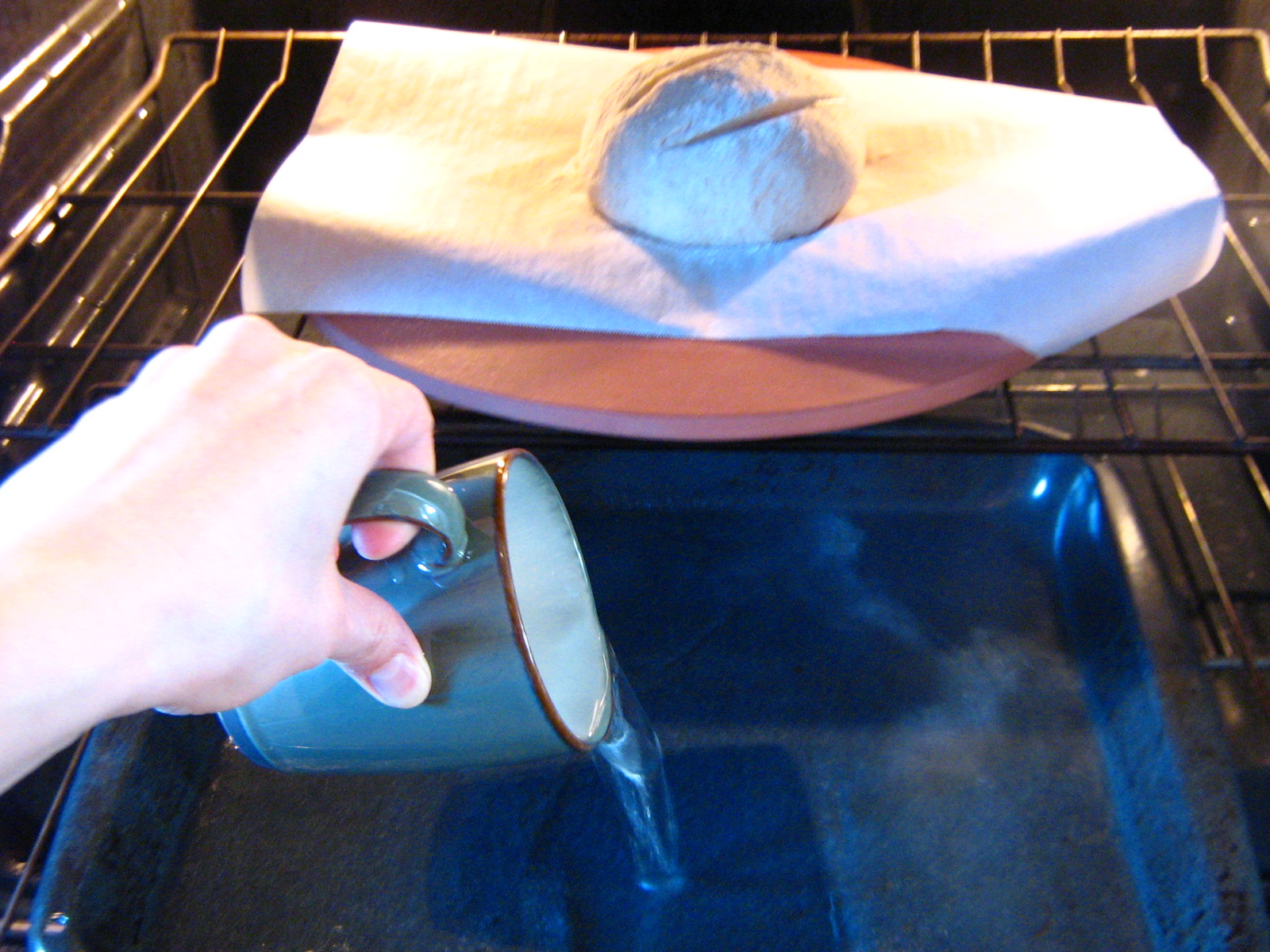 Bake for 30-45 minutes, until the bread is a very deep brown. You will notice that it has expanded quite a bit – this is called oven spring.
Bake for 30-45 minutes, until the bread is a very deep brown. You will notice that it has expanded quite a bit – this is called oven spring.  Let the bread cool completely on a rack before slicing it.
Let the bread cool completely on a rack before slicing it. 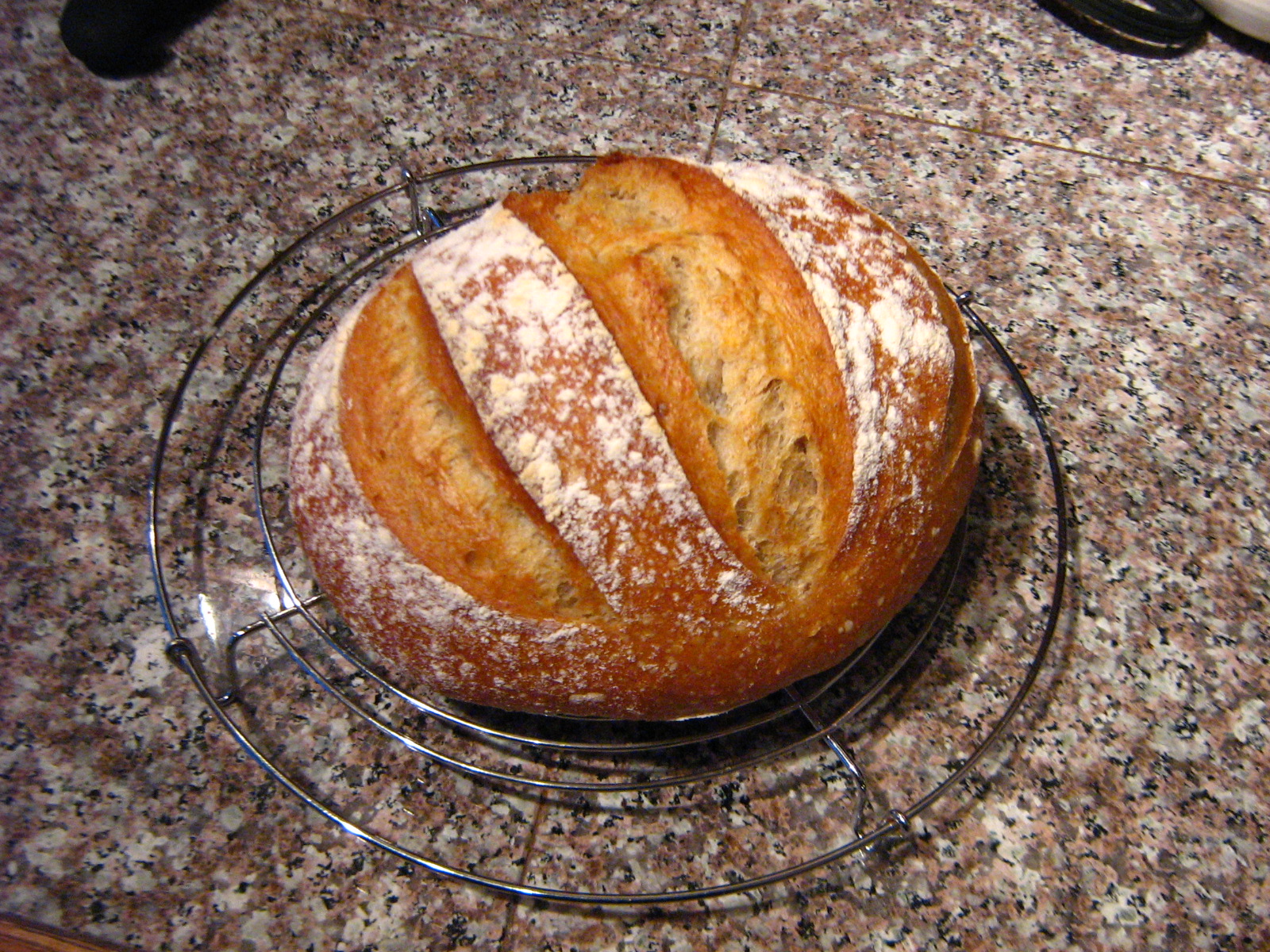 This bread only lasts 2-3 days in our house, so we keep it uncovered on the counter, sitting cut-side down on a cutting board. This way the crust stays crisp and the cut end doesn’t get stale.
This bread only lasts 2-3 days in our house, so we keep it uncovered on the counter, sitting cut-side down on a cutting board. This way the crust stays crisp and the cut end doesn’t get stale.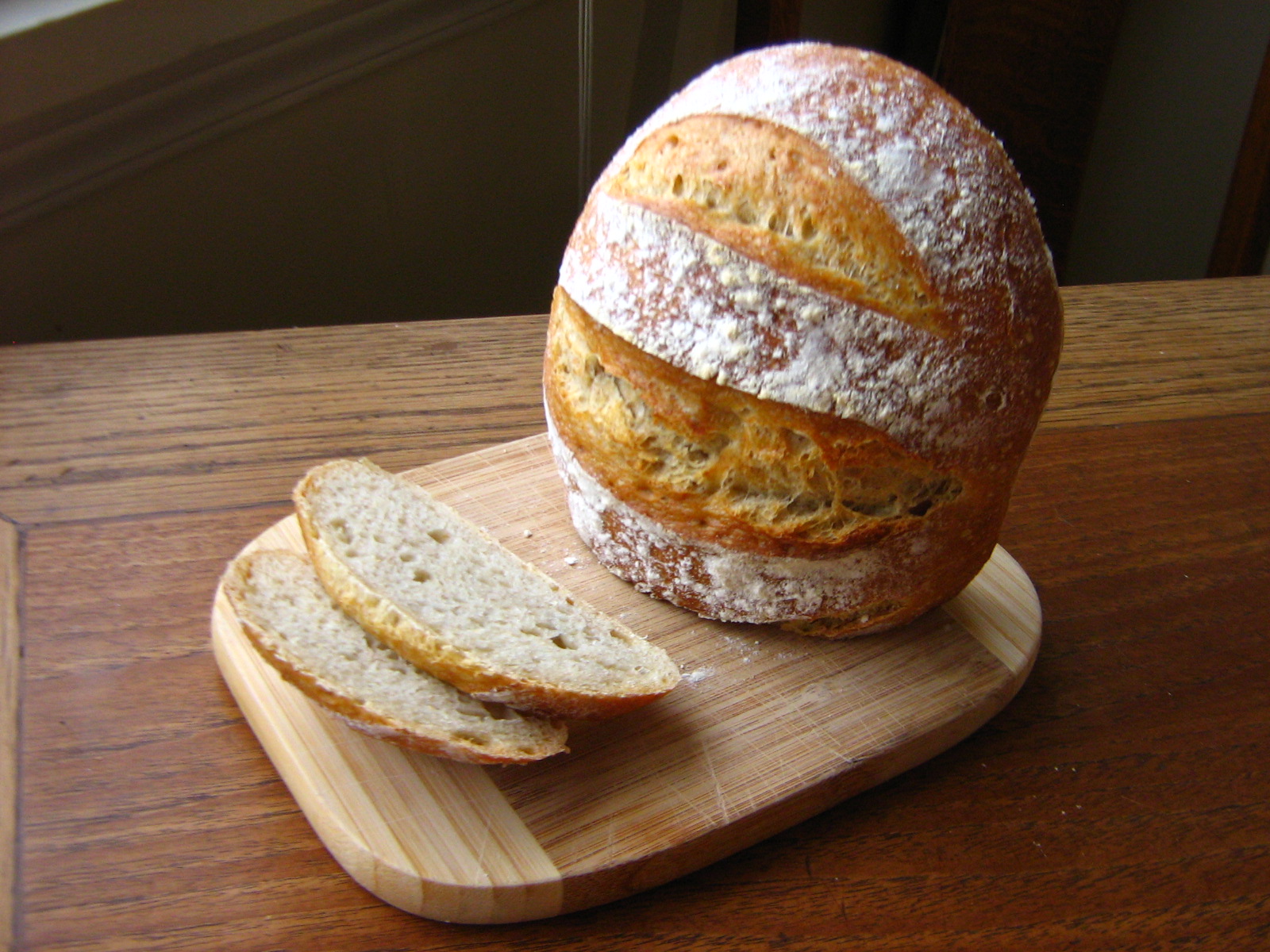
Some notes:
Feel free to make a 1 1/2 – 2 lb loaf – just let it rest and bake longer.
The original recipe was developed using American flour, but Canadian flour is higher in protein (about 12% versus 8-9%) and therefore absorbs more water, so I use 1/3 cup more water than the original recipe calls for. It may take a few tries to play around with the amount of water that works for you – see this post for more information.
If you under-bake the bread, the crust will lose its crispness as it cools. It should be quite dark brown and caramelized-looking when it comes out of the oven. The crust will also lose its crispness if you cut into it while it’s still warm.
The more large air holes inside the bread (an “airy crumb”), the better. This can be achieved with a wetter dough to start with or a longer resting time. One tip is to shape the dough in the morning, then cover it lightly with plastic and let it rest all day in the fridge, then bake it in the evening. This ensures a good long rest and lots of air hole formation. See this post for more tips.
If you don’t have a pizza stone, you can bake this bread in a Dutch oven, which works really well. I’ve also just used a regular baking sheet and the bread came out fine, but a pizza stone gives it a better crust. My pizza stone is handmade of terracotta and was a Christmas present from my parents. I love it!
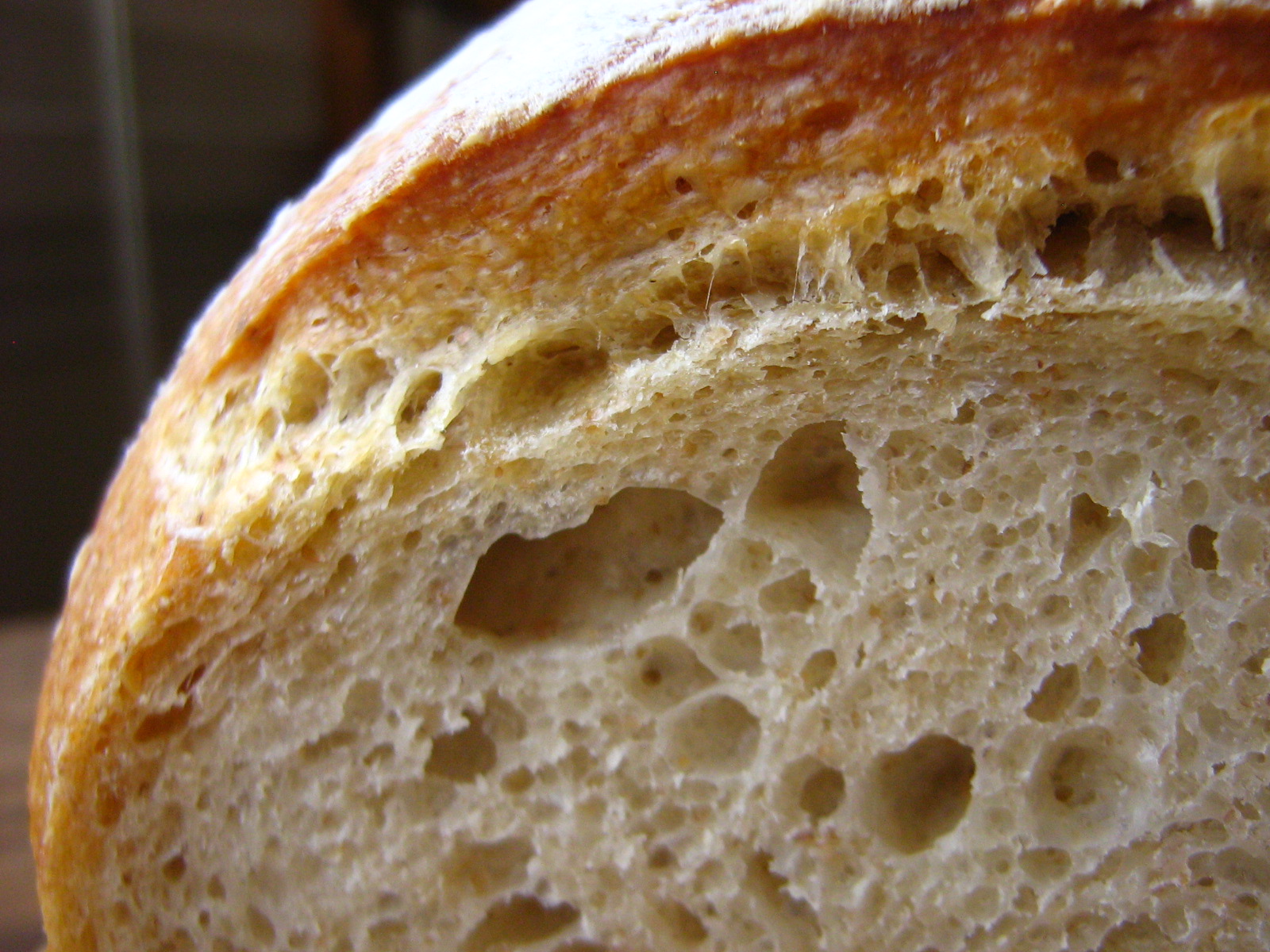
Thank you Korena for an amazing post..I was looking for a good bread book to buy and I think I found it..
bookmarked for trying very very soon
I LOVE this book and would definitely recommend it! They have two more books now as well, and the companion website is totally awesome – the authors will help you out with any questions or problems you have with any of their breads. It’s taken me a while to tweak this recipe to get it just right, but even my earliest attempts turned out delicious bread 🙂 Good luck if you try it Sawsan!!
Looks lovely! 🙂
All I can say? is yum!!! 🙂
Great post! I love the step by step instructions, and the bread looks amazing! I’m going to try it out this week.
Thanks Rose. Good luck!
I have that book and hardly use it. I need to give it another look, always just grab the Bread Bible. This looks fantastic.
I went through a period of not using it for a long time, but I’m back on the wagon. It’s just so easy… (however I can see a bunch of new bread books in my future now that I have the bread making bug!)
This sounds amazing!! Plus I just got a pizza stone for Christmas as well!! I can’t wait to try it! 🙂
DO IT!!!
(Heh, I think we got the same pizza stone… ;))
Beautiful bread! The bread is a wonder! Congratulations to the difficult miracle!
Best regards! Terike
Thank you! Maybe one day my bread will be as gorgeous as yours…
Whew! Superb post! (And I’m so glad you did a link to Melissa’s site regarding the pizza stone.)
Questions: if I were to do this with spelt, what would you suggest as changes in amounts? (I’m thinking that if all the resting develops gluten, that would be particularly good in the spelt circumstance.) I would use light spelt flour (i.e. half the bran removed, so like using half white-which-we-can’t-seem-to-get-over-here and half whole flour.) Anyway, I might try this, if you can make some suggestions or give me some hints for using spelt. It does look absolutely fantastic.
I would use 25% less water (from the 3 cups in the original recipe in the book), so 2 1/4 cups water to 6 1/2 cups spelt flour. And I would mix together the flour, yeast and salt, and then add the water… that way you can add more/less water as needed. And maybe try half a batch the first time! And check out the website for what the dough is supposed to look like – this will help you gauge how much water you should add. Let me know how it goes! 🙂
Actually, here is a recipe from the “Healthy Bread in 5 Minutes a Day” book adapted for spelt bread – but it uses vital wheat gluten, which I suspect is the thing you’re sensitive to…
http://www.npr.org/2011/10/04/141014137/spelt-bread
And I recommend baking it using the Dutch oven method – I suspect the spelt dough will be prone to spreading and the Dutch oven will sort of contain it a bit. Or you could bake it in a loaf tin: 1 1/2 – 2 lbs of dough in a 9″x4″ greased NON-STICK loaf pan, rest for 1 hour 40 mins, then bake as directed (no pizza stone needed with a loaf tin).
I will try this, maybe today. Thanks! 🙂
Hey, would you recommend that book for a beginner? Me and bread anything don’t usually get along.
Hey 🙂 Yes I would. It’s really as easy as mix, shape, and bake, which is good for a beginner! If you want to try the “original” no knead bread (which just makes one loaf, rather than enough dough for 4), check out this post: http://steamykitchen.com/168-no-knead-bread-revisited.html – literally so easy a four-year-old can make it!
Hi there! Stumbled upon your blog while searching homemade phyllo dough, and wanted to say I am impressed. Your pictures are beautiful, your presentation and technique are marvelous, and your writing is witty and articulate. Your blog is a joy to read and I’ll definitely be staying tuned for more!
Thank you very much Alex, I’m flattered! 🙂
That’s an exceptionally beautiful loaf! So simple as well.
I’ll have to try this out – looks delicious. I got a copy of Jim Lahey’s no-knead bread book (http://www.indiebound.org/book/9780393066302/Jim-Lahey/My-Bread) over a year ago, but haven’t had a kitchen, the book, and an appropriate pot together yet.
KORENA!!! Thank you so much for posting this. I just tried it and IT WORKED! Seriously, I’ve made bread successfully before but it’s always tasted kind of… yeasty? Homemade? In a gross way, I mean. This, on the other hand, is delicious! I’m so buying this book.
I did have a question for you. Is there a reason you use parchment, rather than just baking the bread directly on the stone? I nearly had a disaster when I realized that my baking parchment packaging only advises using it up to 420 degrees. It turned a really awful shade of brown but thankfully didn’t light on fire, lol. Do different papers have different heat tolerances? Can I just throw the dough on my breadstone?
I’m so glad it worked out for you!! 🙂 You can definitely bake the bread directly on the pizza stone – I use parchment paper because it’s easier than trying to remove the dough from the surface it was resting on to the hot stone in the oven. In the book they recommend resting the dough on a pizza peel and then sliding it from the peel to the stone, but I don’t have a peel, hence the parchment paper. Instead you could use a (wooden/non-melt-y) cutting board or something like that, dusted with whole wheat flour to help the dough not stick.
(I use Reynold’s brand parchment and it seems fine at 450˚F, but I’ve heard that some brands don’t do so well at higher heat.)
Ah, that might be it then, mine is some Euro brand they randomly sold at Safeway. This time around I tried resting it on floured parchment, with the idea that I could remove it before baking, but it stuck anyway! So I just cut the parchment around the boule and as it’s baking it seems to be expanding and covering up the paper, so less of a fire hazard that way. I hope!
Pizza peel is next on my list of kitchen accessories to acquire. I try to keep gadgets to a minimum but we cook enough homemade and fresh (not frozen) ready-made pizzas that I wish we had a peel at least a few times a month!
PS, I just checked and the Reynold’s parchment also says “temperatures up to 420˚F”, but I’ve had no problems in a 450˚F oven…
The bread looks lovely! Can it be made in glass loaf pans?
Hi Lyndsay – the bread can be baked in a loaf pan, but because it is so wet, it tends to stick to to the pan, unless it has a non-stick coating and is very well-greased. So maybe glass would not be the best option. Here is a post about baking the dough in a loaf pan from the Artisan Bread in 5 website: http://www.artisanbreadinfive.com/2011/09/12/the-best-school-lunches-start-with-homemade-bread
have now begun my jounry of making artian bread wow love it yes canadian flour is much differnt then amerian i also have to use little more water thks ontario canada
Best of luck on your bread making journey, Diane 🙂
I love moist dough! To make the crust “crusty” I bake my loafs under a lid in a dutch oven for the first 20 minutes. That helps maintaining moister for a while. Haven’t even thought of having a tray of water under the pizza stone!
I’ve baked it in a Dutch oven too – either way works! The tray of water is good especially when you are baking multiple loaves or the bread won’t fit into a Dutch oven.
Hello Korena,
Thank you for this post. It was incredibly easy to follow, and a great success. I wrote about it here: http://www.ashleymarieskitchen.com/2013/03/artisan-bread-easy-introduction.html, would love to hear feedback if you check it out. Thanks again!
ashley
I will check it out right now! Thanks for your comment!
how did the spelt flour version turn out?
I think the report on the spelt version was that it was kind of flat… the delicate gluten in spelt might not be well-suited to this bread after all…